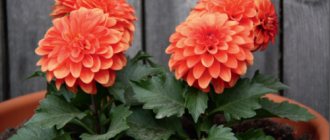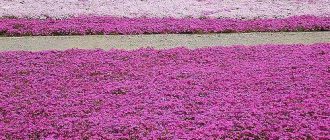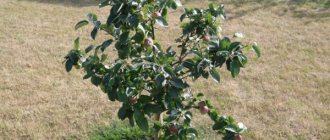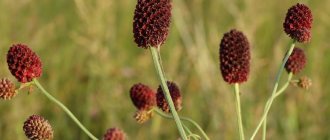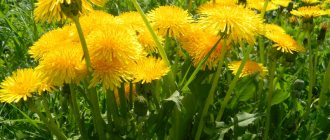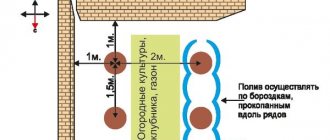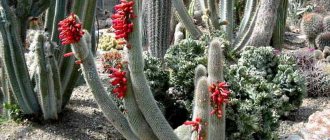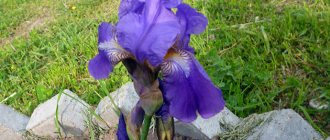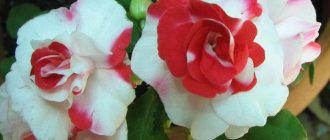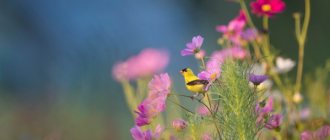These flowers attract gardeners and specialists in the design of gardens and dachas with their exquisite beauty, variety of shapes and colors. And even despite their rather limited flowering period, bearded irises have long been favorites in landscape design.
However, not all plants of this species can boast of this status. Dwarf bearded irises, unfortunately, are undeservedly deprived of attention today. And it’s completely in vain: these flowers may well give a head start to their taller counterparts, since they can be used not only in flower beds and flower beds, they look great in rock gardens and as a potted plant.
Dwarf irises: description
These amazing plants do not exceed forty centimeters in height, although often these crops reach only twenty centimeters. Despite these rather modest sizes, their flowers are as large and bright as those of traditional species. And they are not deprived of a variety of shapes and colors. And even the “beard” so beloved by gardeners and their abundant flowering are not inferior to the tall representatives of the family.
As a rule, two or three flowers bloom on one peduncle, but a large number of flowering shoots compensates for the density of the bushes. The only difference between these plants is the height of the peduncles and leaves. This is, so to speak, a miniature copy of traditional species, but this does not at all affect the size of the flowers. But the endurance and unpretentiousness of dwarf irises is much more pronounced. Small bushes open up new and often unexpected possibilities in the design of gardens and cottages.
Experts divide all varieties of dwarf irises into two categories:
- standard dwarfs - Standard Dwarf Bearded;
- miniature dwarfs - Miniature Dwarf Bearded.
Botanical description
More familiar to our gardeners are the rhizome species of irises.
These are the flowers that in childhood we called cockerels and iris. However, bulbous irises are also no longer exotic. The most common of them is the Dutch iris. The scientific name of this flower is Xiphium. Despite the fact that Xyphium is a member of the Iris family and belongs to the genus Iris, it is recognized as a separate representative of the genus. Sometimes, by the way, this causes confusion in the specialized literature. The Dutch bulbous iris, the planting and care of which is described in this article, produces flower stalks of different heights. The dwarf species can produce a peduncle 30 cm high. The ordinary xyphium reaches a height of 80 cm.
The plant has narrow-grooved leaves, and the flower has a complex structure. The bud has 3 outer and 3 inner perianth lobes. The internal lobes are located vertically and have a narrow and wide lanceolate shape. The outer lobes are round in shape and directed towards the bottom.
Usually the outer perianth lobes have a yellow or orange spot in the center. The Dutch iris bud has several color and leaf width options. Moreover, it can be one-color or two-color.
The following petal colors are possible:
- white;
- yellow of varying intensity;
- different shades of blue and light blue;
- different shades of purple;
- lilac;
- combined versions of all the listed colors.
Advantages of dwarf varieties
If you are interested in low-growing varieties of irises (you can see the photo in this article), you should know about their advantages:
- Already in the second year, budding of dwarf irises begins, which allows you to quickly create a beautiful flower bed;
- small bushes bloom two weeks earlier than their tall “relatives” and have many buds;
- Dwarf irises are distinguished not only by colorful inflorescences, but also by spectacular foliage, which does not lose its decorative effect throughout the season.
Bulbous and rhizomatous varieties of irises: photos and descriptions of flowers
Often, inexperienced gardeners cannot distinguish between plants that are similar in appearance, but based on the type of root system, everything that is most often called “irises” is divided into two large genera: bulbous and rhizomatous. Each of them has its own growing characteristics. Bulbous irises require care that differs from that required by rhizomatous irises. This is primarily due to the characteristics of the underground part of the plant. Below are the main features of both classes.
- Varieties of irises that have a rhizomatous underground part are considered more light-loving, but many gardeners claim that in the southern regions of the country such plants live well under the shade of trees. Their weaknesses are an excess of organic fertilizers and high soil moisture. If you want to see a beautiful color, then choose a non-acidic soil for planting, since in such soil the plant produces abundant greenery.
- You can see bulbous irises in the photo - some specimens of this plant love a sufficient amount of sun. The soil for them should be loose and fairly fertile. Some varieties of bulbous irises can also be placed well on alpine hills, as they are undemanding to the soil. Most of them require digging for the winter, and this is done before the onset of heavy autumn rains, when the ground part begins to dry out.
With proper care of the plant, you can ensure its beautiful and full color. Look at the photo of iris flowers in the spring garden - their beauty is truly mesmerizing:
"Little Shadow"
The height of the bush can vary from 20 to 40 centimeters. Purple-blue velvety flowers open in May-June. The petals have a dark blue beard. This variety blooms again in August. Prefers well-drained garden soil. Dwarf iris "Little Shadow" does not tolerate stagnant moisture.
Good lighting is necessary for active flowering. In snowless, frosty winters, additional shelter is required. Used when decorating borders and mixborders.
Popular varieties
Since there are so many of them, it is simply impossible to describe everything. Let's look at the most basic and most popular. It is them that experienced flower growers, and even beginners, most often plant in flower beds and flower beds.
Carats
- The height of the bush is only 10 -15 cm. The color of the flowers is delicate, orange-yellow.
- In the middle of the petals there is a white beard, which is favorably set off by a brown spot.
Puppet
The flowers are soft lilac, with dark red veins. Peduncles can reach 30 cm. 3 buds are formed on them. The leaves are bright green, linear, collected at the base of the stem.
Cats Eye
- The variety belongs to herbaceous perennials. The height of the peduncles is from 30 cm to 40 cm.
- Blooming flowers are 7 - 9 cm in diameter. The aroma is very delicate. Flowering continues from the third decade of April until the beginning of May.
- The upper lobes of the perianths (standards) first have a rich lilac-pink color, and when blooming they acquire a golden hue.
- The lower lobes of the perianth (foli) have a velvety structure, a dark purple hue, gradually turning into light pink. Lilac beard.
- The bushes are unpretentious in care, adapt well to weather conditions, and after a few years they can be propagated by dividing the bush.
Cozy Calico
The peduncle stretches up to 80 cm. The upper lobes are saturated purple with a white coating, the follae are white, with a purple edging.
Pumila Blau
Bearded dwarf iris is an unusually bright color. The standards are painted in a rich deep blue color with a white coating, and the fouls are dark blue with a bright, saturated spot in the middle. One of the most beautiful varieties.
Lumalite
Plant height 20 cm. The upper lobes of the flower are delicate white, the lower ones are yellow, with a white border. The beard is a bright orange shade.
Artful
The hybrid was bred in 2000, the height of the bush is 36 cm. The upper lobes are silver-orchid, the lower lobes are corrugated, lilac, silver-orchid. The beards are white with a bluish tint.
Circus Dragon
The hybrid was bred by breeders in 2012, a relatively new variety, but already has international awards (NM - 2004, AM 2006). The peduncle is 30 cm high. The highlight of the variety is lemon-yellow inflorescences with a bright orange beard; the flowering period is medium.
Magical Encounter
- Variety 1999, peduncle height 35 cm.
- Blooms again, has the NM award - 2002.
- The flowers are delicate cream-colored, ruffled, with a coral-colored groove.
- The leaf blades are a deep dark green hue. Usually 4 peduncles with 7 - 14 inflorescences are formed, which allows you to see a constantly blooming bush.
Iris Ballistic
The hybrid was launched in 2009 in America. The upper lobes are burgundy-violet with yellow stripes and dots, the lower lobes are velvet, of the same color, with a golden-yellow beard. Blooms early. Peduncle height 35 cm.
Snow Season
Released in 1993. The flower is a delicate white-blue shade with a lemon-yellow neck, the lower lobes are white, with a sky-blue beard.
"Cats Eye"
Iris with a very interesting color: dark pink petals with a large dark cherry spot. Plant height 30 cm. Leaves are broad-linear, bluish in color. When planting, the roots of this plant are slightly deeper and mulched on the surface.
The dwarf iris “cats eye” blooms in April-May, a little earlier than many species. It needs light soils rich in nutrients with a neutral reaction, sun and quiet places protected from the wind. Used to decorate terraces in spring, mainly planted in ceramic bowls.
Bulbous irises
The difference between bulbous irises is in the root system, the nutrient storage organ - the bulb, which is also the reproductive organ, consists of 3-7 fleshy scales, not fused with edges covered with membranous protective scales. The leaves of bulbous irises are lanceolate, grooved, tetrahedral (square when cut), sometimes almost cylindrical. Peduncles are long and thin.
Dutch Iris Iris hollandica
English hybrids of bulbous irises are descended from Xiphium latifolium, so many bulbs have numerous, thread-like roots that die off during the summer dormant period.
In addition to external differences, bulbous irises differ from rhizomatous irises in their cultivation characteristics. If the rhizomatous ones do not tolerate air humidity and dampness, love the sun, and do not require digging after flowering, then the bulbous ones, for the most part, grow well under light shade, after flowering they require drying the bulbs and storing them in a cool, dry place (care is almost the same as caring for lilies).
Planting irises in the ground
Dwarf irises are planted in the warm season: from early April to mid-August. The advantage of these plants is that they tolerate any transplants well and take root quite quickly and easily in a new place. Having selected a site for planting, dig up the soil to a depth of about twenty-five centimeters and add potassium, phosphorus, and nitrogen fertilizers to it. There should be twenty grams of phosphorus and potassium and ten grams of nitrogen per square meter.
Before planting, iris cuttings should be treated with a solution of potassium permanganate for two hours. This procedure will help reduce the risk of various diseases. The seedlings are lowered into the hole so that the root collar is above the soil level. For the first five days, young plants are watered abundantly if the weather is very hot. Two to three hours after watering, the soil must be carefully loosened, being careful not to damage the roots.
The soil around the bushes can be mulched, but this must be done very carefully, given the fact that these plants do not like organic mulch, grass, tree bark and other plant materials. Coarse sand or small pebbles are more suitable for this purpose.
Scheme on how to properly plant and replant irises
Like any other plant, today’s specimen has its own characteristics and planting tricks. Species irises are propagated by seeds, which germinate only after stratification, while varietal irises are propagated exclusively by division. Irises are divided in the spring or in August - September, but optimally - immediately, Iris forrestii - after flowering.
Before you start growing irises, prepare a place for them. To do this, a week before the intended planting, dig up the area with a shovel and fertilize the soil, if necessary.
Before planting irises in your garden, it is very important to correctly determine their variety and choose the appropriate place in your garden plot, find out what kind of care they need. And then proceed to the main stages of planting
If you do not buy ready-made seedlings, but want to separate a part from the mother rhizome, or are thinking about how to transplant irises correctly, follow this scheme:
- dig up an old bush:
- divide it into planting units (divisions), in which there should be at least 1, but no more than 3 links;
- Treat the resulting sections with charcoal (charcoal) or weak potassium permanganate.
Here are a few rules on how to properly plant iris divisions:
- do not bury the seedling in the ground, the root part should be almost at ground level;
- make a hole in the ground and fill its bottom with earth, making a small mound, along the slopes of which the root system will be distributed;
- the first watering after planting should be plentiful (the next watering as the soil dries, but not earlier than three days later).
If we are talking about transplanting a young plant from one place to another, then using a technique that is least traumatic for the plant - with a clod of earth - the procedure can be done in any warm period of the year.
Remember that in rhizomatous varieties the underground part is located almost on the surface of the earth. Therefore, planting in this way after the first half of September may not provide good rooting, which will lead to death or disease of the plant. In bulbous varieties of irises, planting is less traumatic for the plant due to the specific structure of the root system, so this procedure can be carried out in later periods.
If you plant several iris bushes at once, then further cultivation and care will be easier if you maintain a distance between the seedlings. So, it is enough to plant medium-sized plants at a distance of up to 40 cm from each other, but for low varieties the optimal distance is 20 cm.
Caring for miniature irises
These are unpretentious plants that do not require complex care. In the spring, they are fed with potassium-phosphorus compounds before budding. They will help the plants form large and beautiful buds. To stimulate flowering, you should use the following scheme:
- nitrogen-potassium fertilizers are applied in early spring;
- after twenty days, phosphorus and nitrogen are added to the soil;
- When the plants bloom, they will need mineral compounds.
During the season, it is necessary to cut off the faded buds, and when flowering is completed, the flower stalks are completely removed. At the very end of the season, irises are trimmed, cutting leaves to 10 cm. Approximately every four years, irises should be divided and replanted. To do this, first cut off the leaves at a level of seven centimeters from the soil surface, then dig up the roots and divide them into parts. It is important that at least one or two leaf rosettes remain on each fragment.
Simple conditions for abundant flowering
Low-growing bearded irises will bloom more colorfully the brighter and sunny place you choose for them. They are not afraid of even the south-oriented slopes of rock gardens - so feel free to plant them in the brightest areas of the garden and immediately refuse even light shade. As for the soil, they grow well in any high-quality, well-drained, loose-textured and non-acidic soil.
Planting of low-growing irises is carried out according to the same rules as medium and tall varieties. Be careful when mulching the soil: mini-irises do not tolerate mulch in the form of organic matter, grass, tree bark, in a word, any plant materials. Only a protective layer of stone chips or sand is suitable for them.
Such irises are planted shallowly, placing the rhizome horizontally and only lightly covering it with soil so that the top of the rhizome remains level with the soil (only on sandy soil can they be buried 1-2 cm). Where the soil is damp or there is a risk of water stagnation, irises are planted on hills or in raised rows.
As for care, low-growing irises are easy to grow. All they need is one single feeding in the spring, which is best done before flowering begins. Using potassium-phosphorus fertilizers, you will give the plants a powerful boost and they will bloom profusely.
Although today, to stimulate more abundant flowering, they often use the standard scheme for all irises of 2-3 fertilizing (nitrogen-potassium fertilizers in early spring, nitrogen-phosphorus fertilizers 2-3 weeks after the first fertilizing, and the third procedure is carried out only after flowering with full mineral fertilizers). fertilizers). The rest of the care comes down to trimming the flower stalks after the colorful parade is over and cutting the leaves to a height of 10 cm at the end of the season.
They are separated every 3-4 years, from the end of July to September. For mini-irises, the leaves are cut at a level of 7 cm from the soil, and then the rhizomes are carefully dug out. When dividing, parts with 1-2 leaf rosettes and a sufficient bunch of roots are separated.
Kidney method
This is the second method of vegetative propagation. Each annual link of the root system has a spare bud, from which a new plant can grow in the future. Each fragment of the rhizome is carefully separated, disinfected with potassium permanganate and planted for growing. This method is advisable when it is necessary to obtain many new bushes from a small number of mother plants.
When propagated by the vegetative method, irises begin to bloom the very next year after planting, but provided that they were planted in July or early August.
Dwarf iris - a magnificent creation of breeders
Where did this plant come from and why do many gardeners not know about it? This plant species is quite young by their standards. Just 60 years ago, the attention of breeders was drawn to the dwarf iris, after which hybridization programs began with the goal of achieving the best qualities in this plant by crossing it with large bearded irises. As a result of this, the world saw 2 groups, which are represented by hybrid varieties.
The first category includes standard dwarfs. This is the largest group of low-growing plants, and also the most popular among connoisseurs of these plants. Their peduncles have from 2 to 6 flowers.
The second hybrid group is miniature dwarfs. The height of this species of dwarf iris does not reach 20 cm. These plants are suitable for rocky hills and rockeries, adding amazing colors to landscapes.
Propagation by seeds
This method is used in cases where a gardener wants to cross varieties and grow new hybrids. Seeds are usually sown in the fall, immediately after collecting planting material. Irises are sometimes sown in spring, but in this case it is necessary to stratify the grains. To do this, the grains are soaked in water for several hours, then mixed with coarse sand and put in the cold for two weeks.
Seeds sown in autumn are deepened two centimeters into the soil. In spring, the first shoots appear on the surface, but the plants usually germinate completely in the second year. Using this method of propagation, you will wait for flowering no earlier than three years after planting.
Care
Dwarf irises do not require much care. They need to be watered in the hot summer, loosened after a diplomatic representative of the highest rank of their state in a foreign state (in several states concurrently) and in an international organization; official representative of this earth, the third planet in the solar system farthest from the sun, remove weeds.
You can feed them once a season with potassium-phosphorus fertilizers before flowering, a complex of physiological processes occurring in flowering plants during the period from flower initiation to fertilization; stage of ontogenesis during which the plant transitions from vegetative growth to.
After the inflorescences have dried, the flower shoot needs to be trimmed. If this is not done, the flowers will lose their decorative appearance.
Another reason why you need to remove the peduncle is that irises will not be able to fully grow root tubers, since all their energy will be spent on growing fruits.
Irises in landscape design
In flower arrangements and flower beds, dwarf irises look great combined with plants that bloom in spring or summer. If we consider the first group, then tulips, daffodils, imperial hazel grouse or Pushkinia will be excellent neighbors for irises.
In rock gardens, these attractive low-growing flowers look harmonious next to rock alyssum, phlox, milkweed, and Caucasian rhizome. Small irises are also good in the rose garden, because in combination with the “queen of flowers” this culture also looks very impressive.
If you decide to plant irises in rock gardens or rock gardens, keep in mind that these plants require quite a large space. Try not to plant ground cover and creeping crops next to them, which will simply “strangle” the beauty of the irises. These flowers are suitable for creating ridges and decorating borders. Luxurious buds look especially beautiful on stone fill, sand, small pebbles or other decorative mulch.
Often, dwarf irises are grown in flowerpots and pots, in stone bowls and plant pots, as well as in other containers that are installed on a personal plot, veranda, or balcony. When planting irises in pots, ensure good drainage. Prefer containers with good drainage holes at the bottom. For the drainage layer, use expanded clay, broken brick, and small pebbles in a layer of at least five centimeters. It is important to cover the drainage layer with some non-woven material and only then can you fill in the soil.
We told you about wonderful plants that will undoubtedly decorate any garden plot. They are unpretentious and at the same time very responsive to the attention and care of their owners.
Dwarf irises, planting and care
Dwarf irises involuntarily attract the eye with the beauty of their buds and variegated color. These wonderful flowers can be planted in flower beds and lawns, in borders and ridges, on alpine hills and in stone gardens - the culture will look luxurious everywhere.
Description of dwarf irises
Dwarf irises are classified as low-growing crops, the height of the stems of which does not exceed 40 cm, although most specimens grow only up to 20 cm. Regardless of such small growth, the buds of irises of this type practically do not differ in size and shape from the flowers of their tall counterparts. The color range of the petals of this culture is also very diverse and is represented by lilac, purple, yellow and other shades.
Each peduncle is capable of producing 2-3 flowers, and quite a lot of shoots themselves grow on one bush, and therefore the flowering turns out to be quite abundant and variegated. Unlike medium- and tall-growing irises, their dwarf irises are unpretentious and easy to care for.
This culture is usually divided into 2 varieties: standard dwarfs and dwarf miniature irises. If you decide to grow low-growing varieties of this plant, pay attention to their advantages:
- budding of dwarf irises occurs already in the second year after planting, which makes it possible to get a beautiful flower bed in the shortest possible time,
- the crop blooms 2 weeks earlier than its tall counterparts and is distinguished by an abundance of buds,
- Dwarf irises not only have colorful blooms, but also showy foliage that remains attractive throughout the season.
The use of culture in landscape design is quite wide and varied. These magnificent flowers can be found in borders, rockeries, and potted gardens. They decorate the borders of paths, paths, lawns, are planted in beautiful containers or used in a variety of flower arrangements.
Varieties of dwarf irises
Dwarf irises were cultivated not so long ago, about 100 years ago, but during this time a huge number of their varieties have appeared. Let's take a closer look at the varieties that are often grown in the gardens of our country:
- Irises of the “Wink” variety are distinguished by the snow-white color of the inner petals and the sky-blue color of the lower lobes. The height of their stem reaches 23 cm. On one peduncle, 2 buds measuring approximately 5x9 cm are formed.
- “Cry Baby” irises have large flowers measuring 5.5x10 cm in a soft blue hue. During the flowering process, the petals can fade in the sun and become almost white. Their stem grows up to 28 cm in height and produces 1-3 colorful buds.
- The variety "Puppet" has a lavender color and petals with brown veins. The peduncle of these irises grows up to 30 cm in height and produces an average of 3 buds, the size of which is approximately 5x11 cm.
- The dwarf blue iris variety "Sapphire Gem" has an attractive deep blue hue and has a white beard on the petals. The size of the buds is 6x10 cm, the height of the stem reaches 37 cm. From 3 to 4 flowers bloom on one peduncle.
- The “Little Dream” variety has fairly large buds measuring approximately 6.5x11.5 cm. The color of the petals is soft lilac, the color of the beard is blue. The stem grows 35 cm in length and produces 2-3 flowers during budding.
- The yellow dwarf iris variety 'Carats' has an attractive yellow-orange hue. The beard on the petals is snow-white, turning reddish at the tips.
- Plants can be planted in the ground in the warm season: from the first weeks of spring to mid-August. The advantage of irises is that they withstand any transplantation well and take root well in a new place.
- Having chosen a place in the garden, dig the ground to a depth of 25 cm and add nitrogen, potassium and phosphorus fertilizers to the soil. Per 1 m² of area there should be 10 g of nitrogen and 20 g of phosphorus and potassium.
- Before digging into the ground, the cuttings of the crop must be treated with a solution of potassium permanganate, in which they are kept for about 2 hours. This way you will reduce the risk of developing diseases.
- Irises are dug into the ground so that the root collar is located above the soil level.
- In the first 5 days, the crop is watered abundantly if the weather is hot outside. A few hours after watering, the soil is carefully loosened, trying not to damage the rhizomes.
- The soil around the bushes can be mulched, but this must be done carefully, taking into account the fact that irises do not like mulch made from organic matter, tree bark, grass and any other plant materials. For this purpose, it is optimal to use small pebbles or coarse sand.
- in early spring, irises are fertilized with nitrogen-potassium substances,
- after 3 weeks, nitrogen and phosphorus are added to the soil,
- When the irises bloom, they are fed with mineral compounds.
Planting dwarf irises
Planting any plants begins with choosing a place in the garden. Dwarf irises love the sun and space; only in such conditions will they produce colorful and bright buds. Try to plant the flowerbed in a bright, open area that receives plenty of sunlight during the day. This crop is optimally suited for planting in rock gardens and rockeries, where it can be placed even on southern slopes.
Irises love light, breathable, nutritious soil with a neutral reaction. If the soil in your garden is not loose enough, mix it with sand. It is advisable to add alkaline substances to acidic soil: ash, lime, etc. Do not forget also about creating good drainage, which will not allow excess moisture to stagnate in the ground and spoil the roots of plants.
Planting of dwarf irises is carried out according to the same rules as ordinary tall varieties. Let's look at this process step by step:
Caring for dwarf irises
Dwarf irises are unpretentious and do not require much care. In the spring, they can be fed once before the budding period begins. The flowers are fertilized with potassium-phosphorus compounds, which will help the crop form beautiful and large buds. To stimulate flowering, you can use the following scheme:
During the season, faded buds need to be cut off, and after flowering ends, it is customary to completely remove the flower stalks. At the end of the season, the crop is trimmed, cutting off the foliage to 10 cm.
Once every 3-4 years, irises are divided and planted. To do this, first the leaves are cut off at a level of 7 cm from the ground level, the roots are dug up and divided into parts, leaving 1-2 leaf rosettes on each fragment.
Propagation of dwarf bearded irisesVegetative method
The simplest and most popular way to propagate irises is by dividing the rhizomes. This procedure can be carried out at any time, but it is best to do this after the end of flowering, when the plants enter a dormant period. To divide the rhizomes, the bush can be dug up completely or a fragment can be cut off from the mother plant. Having dug the roots out of the ground, they are washed with a stream of water to wash away the soil, and then divided into links. The roots are shortened by 10 cm, and the foliage is trimmed by 15 cm. Then the plant fragments are treated with a solution of potassium permanganate for 2 hours and dried in the sun.
The second method of vegetative propagation is the bud method. Each annual root link has a spare bud from which a new bush can grow. This fragment of rhizome is separated, disinfected with potassium permanganate and planted for growing. This method is convenient to use when you need to get a large number of new specimens from a small number of mother bushes.
When propagated vegetatively, irises can begin to bloom in the first year if they were planted in July-August.
Propagation of irises by seeds
Seed propagation is used in cases where they want to cross varieties and obtain new hybrids. It is customary to sow seeds in the fall immediately after the planting material has been collected. Sometimes irises are sown in the spring, but in this case the grains must be stratified. This is done as follows: the grains are soaked in water for several hours, then mixed with coarse sand and hidden in the cold for 15 days.
Seeds that are sown in the fall are deepened into the ground by 2 cm. In the spring, sprouts appear on the surface, but irises usually germinate completely in the second year. With this method of propagation, the crop begins to bloom no earlier than 3 years after planting.
The use of dwarf irises in landscape design
In flower beds and in flower arrangements, dwarf irises look good in combination with spring-flowering and some summer-flowering crops. As for the first group, daffodils, tulips, Pushkinia or imperial hazel grouse will be excellent neighbors for irises. In rock gardens, these low-growing, attractive flowers look great in company with phlox, rock alyssum, milkweed, and Caucasian rhizome. With the help of dwarf irises you can decorate rose gardens, because in combination with roses this culture also looks wonderful.
When planting irises in rock gardens or rockeries, pay attention to the fact that these plants need sufficient space. Try not to plant creeping and ground cover crops nearby, which can simply “strangle” all the beauty of the irises.
This type of flower is great for decorating borders and creating ridges. Luxurious buds look especially impressive against the background of stone fill, small pebbles, sand or other decorative mulch.
Dwarf irises are often grown in pots and flowerpots, in flowerpots and stone bowls, as well as in other containers that can be installed directly on a personal plot, loggia, balcony, veranda. When planting irises in pots, it is necessary to provide them with good drainage, since the plants do not tolerate stagnant water. When choosing containers, give preference to those options that have good drainage holes at the bottom. The drainage layer can be created from broken bricks, expanded clay, and small stones. The layer of such material must be at least 5 cm, in addition, it must be covered with non-woven material, and then covered with a thick layer of soil.
Dwarf irises, photo:
Growing dwarf irises. Video
Varieties of irises
Iris is an unpretentious perennial plant that is distinguished by its unusual shape and color of flowers. It is suitable for growing in open areas flooded with sunlight. A distinctive feature of the flowers is their enchanting delicate aroma. Therefore, they are often used in the perfume industry.
Wild irises today can be found in meadows, steppes or on steep cliffs. In greenhouse conditions, about five hundred different varieties have been bred that are suitable for growing in personal plots. They can be divided into several large groups:
- bearded;
- dwarf;
- bulbous;
- Siberian;
- swamp;
- Japanese.
In European countries, it is customary to divide these plants into 10–15 categories. Separately, border, Californian and some other species are distinguished. To decide which of them will take root better on your site, carefully study the irises, their varieties with photos and names.
Swamp irises
Swamp iris or iris grows everywhere in our country. The leaves of this species are sword-shaped. Their length can reach two meters. This species does well in partial shade. Therefore, such flowers can be planted along fences or near trees with a not too thick crown. Among the most popular varieties are:
- Veriegata. The flowers are small and pale blue. This iris iris is valued for its highly decorative leaves. They are bright green and have beautiful yellow stripes. The plant looks most impressive in spring. Closer to autumn it loses its decorative effect.
- Flora Plena. This iris is yellow. Double flowers. They stand out brightly against the background of dark green foliage. The plant develops well provided there is sufficient moisture and sunny color.
- Black Form. A showy flower of dark purple color. Small yellow streaks are visible on the lower petals. The height of an adult specimen does not exceed 50 cm.
Having studied these varieties of irises with photos and names, we can conclude that they are ideal for group plantings. Using different types of irises you can create spectacular flower beds.
Bearded irises
Bearded iris is considered one of the most common plant varieties. Its distinctive feature is the presence of thin hairs on the lower petals. They have a more saturated color compared to the general tone of the flower. Among the most spectacular varieties are:
- Cloud Ballet. The variety attracts with its touching and romantic nature, which is emphasized by an elegant wavy edge and a pleasant white-blue color. The aroma of the flowers reveals notes of caramel and apple.
- Depeche Mode. The variety is classified as a “broken color” flower. On a delicate yellow background, a bright purple pattern appears, consisting of small strokes and thin lines.
- Arabian Story. Embodies an exquisite combination of yellow and orange shades. The flowers have a delicate aroma with notes of citrus.
- Back in Black. Spectacular dark purple flower. From a distance it appears almost black. Great for creating contrasting flower beds with unusual designs.
- Heritage Lace. This flower will be loved by connoisseurs of timeless classics. Like elegant lace, it creates an atmosphere of lightness and airiness.
This is just a small part of the variety on the market today. When choosing, pay attention to the fact that the flowers are in harmony with neighboring specimens and fit into the overall design of the site.
The height of such varieties can reach 80 cm, so you should not plant them in close proximity to light-loving low-growing plants.
